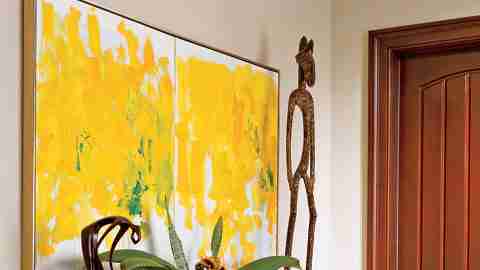Art and Artifact
View Slideshow

When Florence and Edward Paley, like numerous other northerners before them, set out to acquire a house in Florida—an exit strategy from winter—they turned to designer Cecil Hayes, of Cecil's Designers Unlimited, for help. "We like Cecil because everything she does is different," Florence Paley says of the Floridian designer. "She's very innovative and has a great sense of design."
While the property they found, adjoining a lake in Boca Raton, seemed perfect, the house upon it was iffy, at best. "In this area, where there's really no land, there are only two choices—renovate or tear down," Hayes says. When her clients left the decision up to her, she responded with a decisive thumbs-down.
The couple hoped for "large living spaces and room for our art, both contemporary and African."
The dwelling that replaced it was tailor-made for a couple who, having retired from the international business they owned and ran for decades, were ready to say goodbye, not to New Jersey, where they maintain their permanent home, but to the darkest, coldest months of the year.
They had precise requirements. "We wanted a Mediterranean-style house with Spanish and Portuguese interest," Florence Paley says. They also hoped to replicate the unusual ceilings—some vaulted, some of wood—to be found in their Frank Lloyd Wright–inspired year-round residence. ("We like interesting ceilings," Florence Paley says.) In addition, they hoped for "large living spaces," she adds, "especially in the master suite, and room for our art, both contemporary and African."
While they own works by some key American Abstract Expressionists, including Robert Motherwell, the couple also delight in talents that are newer and lesser known. ("Whatever we like, we hang," Florence Paley says. "It doesn't have to be a major, major artist.") They favor African and Asian art, too, some of it acquired in the course of years of business travel.
The master bedroom demonstrates how, through sheer magical thinking, it seems, this designer can will disparate elements into harmony.
At 6,000 square feet, the Florida house is large enough to accommodate visiting family, including the couple's three children and numerous grandchildren; the volume and flow of its rooms make it feel even larger. Its unique personality declares itself at the entranceway, with its inventive juxtapositions. Set beneath an exuberant, yellow-splashed painting by Joan Mitchell, on a Portuguese-inspired console, is a majestic, elongated "pounder"—a flat-bottomed statue that the Senufo of the Ivory Coast use to pound out a rhythm during their tribal rites.
The couple requested white walls, in deference to their collection—"We didn't want anything to fight off the art," Edward Paley explains—but, seeking greater depth and texture, Hayes steered them toward pale faux finishes instead. "We deliberately kept the palette neutral because of the artwork and the boldness of the wood," she says.
Each space makes a strong statement, perhaps none more than the living room, with its dramatic vaulted ceiling that rises to 18 feet at its center point. "The columns frame the room," Hayes points out, and "the very sculptured ceiling is a major player in its look." While some designers might have responded to such powerful architectural elements with a formal interior design, that's never been Hayes's style. Instead, by deploying an army of rich textures and surfaces to counteract the room's strong geometric lines, she created a warm, inviting space that has an elegance that's all the more striking for seeming offhand.
The limestone fireplace demonstrates, in microcosm, how she worked. In this case, she softened its strict angularity by adding a folkloric-looking carved wood mantelpiece, as well as a corresponding trim at the top of the chimney, both of African wood and of her own design. (While a fireplace may seem counterintuitive in this near-tropical climate, it wasn't to these northeasterners, who simply couldn't imagine life without one.)
Perched on the mantel, the Bobo butterfly mask from Burkina Faso, used in dancing ceremonies, is just one of many unexpected objects in the room. The Malinke ceremonial chair from Guinea to its right was a last-minute addition. "I said, You've got to have this; we'll just move everything to fit it in,'" Hayes recalls. Elaborately carved, with a distinct personality, it adds a touch of whimsy and intrigue.
Similarly, in the master bedroom, a wood Pygmy bed, added at the 11th hour, became that extra, unexpected element that can nudge a well-designed space even closer to the sublime. "I saw that bed and said, I've got to make a place for it,'" Hayes remembers. Of all the rooms here, none demonstrates more than this one how, through sheer magical thinking, it seems, this designer can will disparate elements into harmony. To create the headboard, partially made from a bifold Indonesian screen, she employed a not-so-secret weapon—her husband, Arzell Powell, a master craftsman who, as head of the manufacturing branch of Cecil's Designers Unlimited, routinely translates her ideas into solid form. "I do things that give him a challenge," she says. "I love being creative and coming up with one piece that's uniquely yours, that I'll never design for anyone else."
The Paleys enjoy pieces "with a story," Hayes says; in their bedroom especially, there's much to tell. The Pygmy bed alone—so tiny!—causes the imagination to race. And some elements aren't quite what they seem, including the pillows and throw from the Congo, made of Kuba cloth, which, while it feels as soft as fabric, is actually woven straw.
An art- and artifact-focused house presents its own challenges, Hayes reflects: "It's a question of bringing the strength of the design up to the level of the art." As to whether she succeeded, her clients have no doubt. "She got the feeling of exactly what we liked," Florence Paley says. "We built the house we wanted to build."